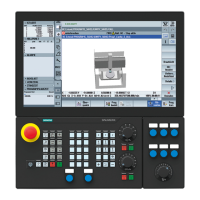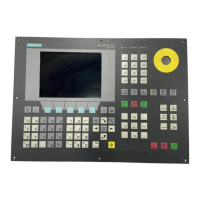Detailed Description
2.1 Tool
Tool Compensation (W1)
Function Manual, 08/2005 Edition, 6FC5397-0BP10-0BA0
2-7
• If tool management is not active and
MD20096 $MC_T_M_ADDRESS_EXT_IS_SPINO = TRUE, D4 refers to tool "5" (as with
active tool management).
Address extension 1 (T1= ..., M1= ...) addresses the master spindle.
Note
Previously, when tool management was not activated, each tool change command
(programmed with T or M) caused the tool compensation to be recalculated in the path. The
address extension is not defined further by this operation. The meaning of the extension is
defined by the user (in the PLC user program).
2.1.5 Free D number allocation
"Relative" D numbers
In the NCK, it is possible to manage the D numbers as "relative" D numbers for the tool
compensation data sets. The corresponding D numbers are assigned to each T number. The
maximum number of D numbers was previously limited to 9.
Functions
Expansions to functions when assigning D numbers:
• Machine data:
MD18105 $MN_MM_MAX_CUTTING_EDGE_NO
is used to define the maximum permissible D number.
The default value is 9, in order to maintain compatibility with existing applications.
• The number of cutting edges (or compensation data sets) can also be defined on a tool-
specific basis using machine data:
MD18106 $MN_MM_MAX_CUTTING_EDGE_PERTOOL.
This allows you to customize the number of cutting edges to be configured for each tool
to the actual number of real cutting edges for monitoring purposes.
• It is also possible to rename D numbers in the NCK and thus to allocate any D numbers
to the cutting edges.
Note
In addition to relative D number allocation, the D numbers can also be assigned as "flat" or
"absolute" D numbers (1-32000) without a reference to a T number (within the "Flat D
number structure" function).

